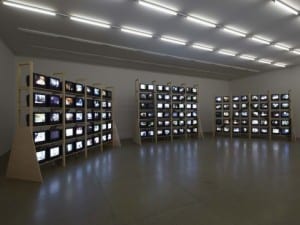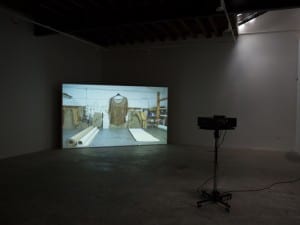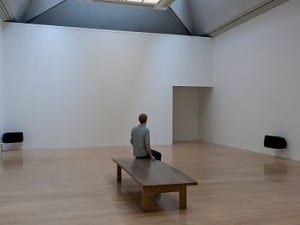The Royal Scottish Academy’s dual-part Resident ’14 exhibition has brought together 15 artists who have undertaken residences at venues across Scotland funded by the Royal Scottish Academy Residences Programme. By its very nature, the exhibition is diverse, with artists included in the show working across the full range of media, with film, multimedia, painting, drawing, photography and sculpture all represented.
One of the pleasures of the exhibition is of course to see in what ways the residency has influenced the artists’ work. In the case of Sonja Witts, whose previous work has been more situated in the traditions of painting and sculpture, a printmaking residency has enabled her to produce an extensive suite of stone lithographs, which she presents alongside a weighty lithography stone on which is printed a design. Witts takes the fundamentals of printmaking processes, impression, reflection and transfer and relates these to the subject matter of maternity and motherhood, drawing parallels between learning the printmaking process and acclimatizing to the always changing relationship between parent and child. The works have an exhilarating and disarming tenderness, capturing with a fresh eye the delicate marks and impressions that children make when they are learning to make their own impressions.
In the case of Patricia Cain, on the other hand, it’s the location of the residency itself that has influenced her work. In a residency with the Wilhelmina Barns-Graham Trust, Cain was able not just to work in the studio of Barns-Graham, but to seemingly fully inhabit the great abstract painter and printmaker’s sense of deep colour and minimal forms. The resulting works are breathtaking in their exploration of drawing and painting as a form of thinking in themselves, an abstract form of thinking distinct from more discursive modes.
Equally influenced by place though in a different way, conceptual artist Hannah Brackston’s work for her residency at Glasgow Sculpture Studios involved building a boat (called “Nolly” after some assistance from some curious passersby) and undertaking a project of urban riverology in which she collected, documented and colour coded hundreds of objects from the river Clyde. Encompassing many different aspects, such as product design, consumption and urban space, perhaps the most exciting aspect of Brackston’s project is the way her gesture of building a boat and setting sail on the urban river environment enabled community-building and collaborative adventures with other artists and members of the public alike.
The work of Chris Wells, who has worked on prints for his residency, takes place in an imagined reality which is a surreal version of contemporary Scotland in which, for example, there’s a Contemporary Art and Sandwich Shop. Deft wit and an exuberant, almost Where’s Wally-esque style characterize Wells’ pop cultural art cartoons.
Other highlights of both parts of the Resident ’14 exhibition include Trevor Gordon’s sculptures which seem to fluctuate between monstrous and organic, Alberta Whittle’s thought-provoking film about movement and ritual and Calum Stirling’s Jean Painleve-like underwater explorations in which marine footage captured in Gairloch and the Summer isles is combined with subtitles from Rainer Werner Fassbinder’s Welt am Draht (1975).
Showcasing the diversity of contemporary art practice in Scotland, the RSA Resident ’14 exhibition manages to convey some of the excitement and focused development of residencies and suggests the importance to artists at all stages of their careers to be given the opportunity to connect with other places, individuals and communities in order to extend and expand their practice.
Colin Herd
RSA – Resident ’14 Part 2. RSA, Edinburgh, www.royalscottishacademy.org.
Credits
1. Patricia Cain Living as a process 150 x 111cm Pastel 2014.





